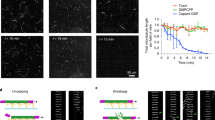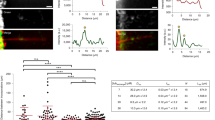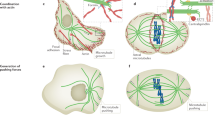Abstract
The dynamic instability of microtubules is characterized by slow growth phases stochastically interrupted by rapid depolymerizations called catastrophes. Rescue events can arrest the depolymerization and restore microtubule elongation. However, the origin of these rescue events remains unexplained. Here we show that microtubule lattice self-repair, in structurally damaged sites, is responsible for the rescue of microtubule growth. Tubulin photo-conversion in cells revealed that free tubulin dimers can incorporate along the shafts of microtubules, especially in regions where microtubules cross each other, form bundles or become bent due to mechanical constraints. These incorporation sites appeared to act as effective rescue sites ensuring microtubule rejuvenation. By securing damaged microtubule growth, the self-repair process supports a mechanosensitive growth by specifically promoting microtubule assembly in regions where they are subjected to physical constraints.
This is a preview of subscription content, access via your institution
Access options
Subscribe to this journal
Receive 12 print issues and online access
$209.00 per year
only $17.42 per issue
Buy this article
- Purchase on Springer Link
- Instant access to full article PDF
Prices may be subject to local taxes which are calculated during checkout








Similar content being viewed by others
References
Mimori-Kiyosue, Y. Shaping microtubules into diverse patterns: Molecular connections for setting up both ends. Cytoskeleton 68, 603–618 (2011).
Hammond, J. W. et al. Posttranslational modifications of tubulin and the polarized transport of kinesin-1 in neurons. Mol. Biol. Cell 21, 572–583 (2010).
Winans, A. M., Collins, S. R. & Meyer, T. Waves of actin and microtubule polymerization drive microtubule-based transport and neurite growth before single axon formation. ELife 5, 1–22 (2016).
Stiess, M. et al. Axon extension occurs independently of centrosomal microtubule nucleation. Science 327, 704–707 (2010).
Wadsworth, P. Regional regulation of microtubule dynamics in polarized, motile cells. Cell Motil. Cytoskeleton 42, 48–59 (1999).
Waterman-Storer, C. M. & Salmon, E. D. Actomyosin-based retrograde flow of microtubules in the lamella of migrating epithelial cells influences microtubule dynamic instability and turnover and is associated with microtubule breakage and treadmilling. J. Cell Biol. 139, 417–434 (1997).
Gundersen, G. G. & Bulinski, J. C. Selective stabilization of microtubules oriented toward the direction of cell migration. Cell 85, 5946–5950 (1988).
Akhtar, N. & Streuli, C. H. An integrin-ILK-microtubule network orients cell polarity and lumen formation in glandular epithelium. Nat. Cell Biol. 15, 17–27 (2012).
Yi, J. et al. Centrosome repositioning in T cells is biphasic and driven by microtubule end-on capture-shrinkage. J. Cell Biol. 202, 779–792 (2013).
Sampath, S. C. et al. The chromosomal passenger complex is required for chromatin-induced microtubule stabilization and spindle assembly. Cell 118, 187–202 (2004).
Grill, S. W., Go, P. & Hyman, A. A. Polarity controls forces governing asymmetric spindle positioning in the Caenorhabditis elegans embryo. Nature 409, 630–633 (2001).
Labbe, J. et al. PAR proteins regulate microtubule dynamics at the cell cortex in C. elegans. Curr. Biol. 13, 707–714 (2003).
Wen, Y. et al. EB1 and APC bind to mDia to stabilize microtubules downstream of Rho and promote cell migration. Nat. Cell Biol. 6, 820–830 (2004).
Etienne-manneville, S. & Hall, A. Cdc42 regulates GSK-3 b and adenomatous polyposis coli to control cell polarity. Nature 421, 753–756 (2003).
Fukata, M. et al. Rac1 and Cdc42 capture microtubules through IQGAP1 and CLIP-170. Cell 109, 873–885 (2002).
Dujardin, D. L. et al. A role for cytoplasmic dynein and LIS1 in directed cell movement. J. Cell Biol. 163, 1205–1211 (2003).
Janson, M. E., de Dood, M. E. & Dogterom, M. Dynamic instability of microtubules is regulated by force. J. Cell Biol. 161, 1029–1034 (2003).
Komarova, Y. A., Vorobjev, I. A. & Borisy, G. G. Life cycle of MTs: persistent growth in the cell interior, asymmetric transition frequencies and effects of the cell boundary. J. Cell Sci. 115, 3527–3539 (2002).
Shelden, E. & Wadsworth, P. Observation and quantification of individual microtubule behavior in vivo: microtubule dynamics are cell-type specific. J. Cell Biol. 120, 935–945 (1993).
Gardner, M. K., Zanic, M. & Howard, J. Microtubule catastrophe and rescue. Curr. Opin. Cell Biol. 25, 14–22 (2013).
Walker, R. A. et al. Dynamic instability of individual microtubules analyzed by video light microscopy: rate constants and transition frequencies. J. Cell Biol. 107, 1437–1448 (1988).
Kowalski, R. J. & Williams, R. C. Microtubule-associated protein 2 alters the dynamic properties of microtubule assembly and disassembly. J. Biol. Chem. 268, 9847–9855 (1993).
Komarova, Y. A., Akhmanova, A., Kojima, S. I., Galjart, N. & Borisy, G. G. Cytoplasmic linker proteins promote microtubule rescue in vivo. J. Cell Biol. 159, 589–599 (2002).
Al-Bassam, J. et al. CLASP promotes microtubule rescue by recruiting tubulin dimers to the microtubule. Dev. Cell 19, 245–258 (2010).
Dimitrov, A. et al. Detection of GTP-tubulin conformation in vivo reveals a role for GTP remnants in microtubule rescues. Science 322, 1353–1356 (2008).
Tropini, C., Roth, E. A., Zanic, M., Gardner, M. K. & Howard, J. Islands containing slowly hydrolyzable GTP analogs promote microtubule rescues. PLoS ONE 7, e30103 (2012).
Schaedel, L. et al. Microtubules self-repair in response to mechanical stress. Nat. Mater. 14, 1156–1163 (2015).
Billger, M. A., Bhatacharjee, G. & Williams, R. C. Dynamic instability of microtubules assembled from microtubule- associated protein-free tubulin: neither variability of growth and shortening rates nor ‘rescue’ requires microtubule-associated proteins. Biochemistry 35, 13656–13663 (1996).
Vitre, B. et al. EB1 regulates microtubule dynamics and tubulin sheet closure in vitro. Nat. Cell Biol. 10, 415–421 (2008).
Arnal, I., Heichette, C., Diamantopoulos, G. S. & Chrétien, D. Clip-170/tubulin-curved oligomers coassemble at microtubule ends and promote rescues. Curr. Biol. 14, 2086–2095 (2004).
Wightman, R. & Turner, S. R. Severing at sites of microtubule crossover contributes to microtubule alignment in cortical arrays. Plant J. 52, 742–751 (2007).
Zhang, Q., Fishel, E., Bertroche, T. & Dixit, R. Microtubule severing at crossover sites by Katanin generates ordered cortical microtubule arrays in Arabidopsis. Curr. Biol. 23, 2191–2195 (2013).
Davis, L. J., Odde, D. J., Block, S. M. & Gross, S. P. The importance of lattice defects in katanin-mediated microtubule severing in vitro. Biophys. J. 82, 2916–2927 (2002).
Díaz-Valencia, J. D. et al. Drosophila katanin-60 depolymerizes and severs at microtubule defects. Biophys. J. 100, 2440–2449 (2011).
Walker, R. A., Inou, S. & Salmon, E. D. Asymmetric behavior of severed microtubule ends after ultraviolet-microbeam irradiation of individual microtubules in vitro. Cell 108, 931–937 (1989).
VanBuren, V., Cassimeris, L. & Odde, D. J. Mechanochemical model of microtubule structure and self-assembly kinetics. Biophys. J. 89, 2911–2926 (2005).
Portran, D., Gaillard, J., Vantard, M. & Théry, M. Quantification of MAP and molecular motor activities on geometrically controlled microtubule networks. Cytoskeleton (Hoboken) 70, 12–23 (2013).
Alushin, G. M. et al. High-resolution microtubule structures reveal the structural transitions in αβ-tubulin upon GTP hydrolysis. Cell 157, 1117–1129 (2014).
Bowne-Anderson, H., Zanic, M., Kauer, M. & Howard, J. Microtubule dynamic instability: a new model with coupled GTP hydrolysis and multistep catastrophe. BioEssays 35, 452–461 (2013).
Zhang, D. et al. Drosophila katanin is a microtubule depolymerase that regulates cortical-microtubule plus-end interactions and cell migration. Nat. Cell Biol. 13, 361–370 (2011).
Charafeddine, R. A. et al. Fidgetin-like 2: a microtubule-based regulator of wound healing. J. Invest. Dermatol. 135, 2309–2318 (2015).
Ward, A. et al. Solid friction between soft filaments. Nat. Mater. 14, 583–588 (2015).
Doodhi, H., Katrukha, E. A., Kapitein, L. C. & Akhmanova, A. Mechanical and geometrical constraints control kinesin-based microtubule guidance. Curr. Biol. 24, 1–7 (2014).
Ahmadzadeh, H., Smith, D. H. & Shenoy, V. B. Mechanical effects of dynamic binding between tau proteins on microtubules during axonal injury. Biophys. J. 109, 2328–2337 (2015).
Bechstedt, S. & Brouhard, G. J. Doublecortin recognizes the 13-protofilament microtubule cooperatively and tracks microtubule ends. Dev. Cell 23, 181–192 (2012).
Shelanski, M. L. Chemistry of the filaments and tubules of brain. J. Histochem. Cytochem. 21, 529–539 (1973).
Malekzadeh-Hemmat, K., Gendry, P. & Launay, J. F. Rat pancreas kinesin: identification and potential binding to microtubules. Cell. Mol. Biol. (Noisy-le-grand). 39, 279–285 (1993).
Hyman, A. et al. Preparation of modified tubulins. Methods Enzymol. 196, 478–485 (1991).
Portran, D. et al. MAP65/Ase1 promote microtubule flexibility. Mol. Biol. Cell 24, 1964–1973 (2013).
Komarova, Y. A. Mammalian end binding proteins control persistent microtubule growth. J. Cell Biol. 184, 691–706 (2009).
Acknowledgements
We thank G. Montagnac for sharing his unpublished data on tubulin photo-activation in cells; and F. Perez and C. Poüs for sharing their unpublished data on the microtubule rescue by CLIP170. This work has been supported by HFSP (RGY0088/2012), ANR funding (ANR-12-BSV5-0014) and ERC (Starting Grant 310472).
Author information
Authors and Affiliations
Contributions
C.A. performed experiments in cells. L.S. and J.G. performed the experiments in vitro. L.B. and M.T. directed the work. C.A., L.S., K.J., L.B. and M.T. analysed the data. M.T. wrote the paper.
Corresponding authors
Ethics declarations
Competing interests
The authors declare no competing financial interests.
Integrated supplementary information
Supplementary Figure 1 Effect of laser intensity on photo damage induced on microtubules.
(a) Examples of microtubules damaged with different laser intensities. Left panel: Microtubule damaged at intermediate laser intensity. The microtubule was structurally damaged, as shown by the kinked shape it displayed when submitted to flow. No severing occurred. Right panel: At high laser intensity, microtubules were cut. (b) Histogram of the distance of the photo-damage site with respect to the tip (set to zero).
Supplementary Figure 2 Microtubules self-repair at photo damage sites.
Microtubules were grown in the device shown in Fig. 4a. Green microtubule seeds were elongated with red free tubulin (step I). Photo damage (yellow star) was induced in the presence of green tubulin (step II). After a two-minute delay, the medium was changed again for red tubulin (step IV). Free fluorescent tubulin dimers were removed and replaced with non-fluorescent dimers to visualize microtubules. The white arrow point at the incorporation of green tubulin along the pre-existing red microtubule following laser-induced damage.
Supplementary Figure 3 Microtubules rescue at photo damage sites.
Kymographs of microtubules showing rescue or depolymerization at photo damage sites (yellow star), analogous to Fig. 4e.
Supplementary Figure 4 Effect of laser power and frequency on microtubule photo-damaging.
(a) Red microtubule seeds were elongated with green free tubulin (step I). A GMPCPP cap was grown at the microtubule tip to avoid spontaneous depolymerization (step II). Photo damage was induced in the absence of free tubulin to avoid microtubule self-repair (step III). Depolymerization was initiated by removing the GMPCPP cap with a laser pulse at high intensity (step IV). In the absence of free tubulin, microtubule could not grow but only depolymerize. The laser-induced damage could only temporally interrupt microtubule depolymerisation (pause). High laser power could break the microtubule. (b) At low laser power and frequency (I), such as the one used throughout the study, photo damaged microtubules depolymerized without pausing. At high laser power and low frequency (II), microtubules broke at the laser damage site and immediately started to depolymerize after fracture. At low laser power and high frequency (III), most microtubules either broke, pausing for a short time before depolymerization (left panel), or paused at the laser damage site (right panel). At high laser power and frequency (IV), microtubules usually paused at the damage site before resuming depolymerization, suggesting that the laser power had a cauterizing effect on the microtubule lattice. (c) Quantification of the events shown in b. Between 17 and 24 events were monitored per condition in 4 independent experiments.
Supplementary Figure 5 EB1 recruitment at microtubule repair sites.
(a) EB3 recruitment at repair sites in the presence of free tubulin. Red microtubules were photodamaged in the presence of red-fluorescent free tubulin dimers and EB3-GFP. Images show microtubule fluorescence in the red (left) and green (right) channels, before (top) and after (bottom) the laser-induced damage. The graph shows fluorescent linescans along this microtubule before and after the damage. The yellow star represents the damaged site. (b) Absence of EB3 recruitment at repair sites in the absence of free tubulin. Same experiment in the absence of free tubulin. (c) Quantification of the effect of laser damage on the ratio of EB3 intensity after/before.
Supplementary Figure 6 Laser photo damage promotes microtubule growth.
(a) Time lapse and kymograph of a microtubule in vivo with multiple photo-damage sites. Microtubule was photo-damaged (yellow stars) close to the tip, promoting multiple rescue events (red arrowhead). Though catastrophe events were frequent, this microtubule was protected from complete depolymerization by the photo damage. Scale bar is 5 μm. (b) Time lapse of a growing microtubule in vitro without or with laser damage. Left, a growing microtubules in absence of laser damage. Right, a growing microtubule in presence of repeated laser damages. Image sequences corresponding to the kymographs shown in Fig. 6a.
Supplementary Figure 7 Self-repair biases microtubule dynamic instability in vivo.
The sheme illustrates laser induced photo-damages either on the microtubules, in the red region, or next to the microtubules, in the green region. The images show the cell before (top) and after (bottom) the shooting. Comparison of the left and right cell margin pre- and post-photo-damage. Scale bar is 5 μm.
Supplementary Figure 8 Laser-induced photo damage on microtubules influences cell migration.
Time series montage of a migrating PtK2 GFP-tubulin cell. Cell migrated 33 min prior photo-damage to the left upper corner of the field of view. Photo-damage at the retracting cell edge (yellow stars) from t = 33 min to t = 75 min changed migration direction towards the photo-damage site. Even after the laser-induced photo-damage was stopped the cell continued the motion towards the bottom right corner of the field of view.
Supplementary information
Supplementary Information
Supplementary Information (PDF 1495 kb)
PtK2 cell expressing mEos2 post photo-conversion.
The microtubule tips grow by incorporating converted tubulin dimers (magenta). (MOV 1498 kb)
PtK2 cell expressing mEos2 post photo-conversion.
Converted free tubulin dimers (magenta) diffused through the cytoplasm. Signal of converted dimers (magenta) was observed at the growing tips as well as in spot-like structures along the length of pre-existing microtubules (green). Video related to Fig. 1a. (MOV 2902 kb)
Self-repair sites are rescue sites. Overview and detail of PtK2 cell expressing mEos2 post photo-conversion.
Incorporation (arrow) of converted tubulin dimers (magenta) in pre-existing microtubule (green). Rescue event occurs exactly at the site of incorporation (arrow). Video related to Fig. 2a. (MOV 1248 kb)
The localization of rescue events in cells are frequently at microtubule crossing site.
White arrow indicates the microtubule tip. Red circle highlights the rescue at microtubule crossing site. PtK2 cells stable expressing GFP-tubulin. (MOV 661 kb)
Representative sites of laser induced photo-damage (red circle) within the cell margin and near the nucleus of PtK2 GFP-tubulin cells.
Microtubules undergo rescue at photo-damage sites. Arrow highlights the dynamic microtubule tip pre- and post-rescue. Video related to Fig. 3c. (MOV 14283 kb)
Detail of microtubule rescue at photo-damage site in vivo.
Multiple rescues at photo-damage site are occurring occasionally, bottom video. Red circle highlights the rescue at photo-damage site. Arrow highlights the dynamic microtubule tip pre- and post-rescue. Video related to Fig. 3d, e. (MOV 1495 kb)
Microtubule rescuing at a photo damage site in vitro.
The upper panel shows a microtubule without laser damage; in these conditions, microtubules rarely undergo spontaneous rescue. The lower panel shows a microtubule rescuing several times at a laser damage site (red circle) before complete depolymerization. Video related to Fig. 4e. (MOV 2148 kb)
Microtubule rescue at cross-over.
The video shows the growth of non-micropatterned and non-photo-damaged microtubules. Microtubule depolymerisation was stopped at the site where microtubules cross each other. (MOV 794 kb)
Laser damage increases microtubule length and life-time.
The upper panel shows a microtubule without laser damage and infrequent rescue events. In the lower panel, the microtubule was damaged repeatedly close to the tip (red circles), inducing rescue and making the microtubule grow longer and longer. Video related to Fig. 6a. (MOV 6823 kb)
Microtubules rescue and over growth upon repeated photo-damages.
PtK2 GFP-tubulin cell. Photo-damage on single microtubule (red dots) or next to microtubules (green dots). Microtubule number and length increased at the site of microtubule photo-damage (red dots) and decreased on the opposite site (green dots). The cell spread toward the site where microtubules were photo-damaged. Video related to Fig. 7. (MOV 3555 kb)
Reoriented migration by photo-damaged microtubules.
PtK2 GFP-tubulin cell migrated 34 min prior photo-damage to the left upper corner of the field of view. Photo-damage of single microtubule (red dots) at the retracting cell edge from t = 33 min to t = 75 min changed migration direction towards the photo-damage site. Even after the offset of photo-damage cell continued the motion towards the right. Video related to Supplementary Fig. 8. (MOV 26223 kb)
Rights and permissions
About this article
Cite this article
Aumeier, C., Schaedel, L., Gaillard, J. et al. Self-repair promotes microtubule rescue. Nat Cell Biol 18, 1054–1064 (2016). https://doi.org/10.1038/ncb3406
Received:
Accepted:
Published:
Issue Date:
DOI: https://doi.org/10.1038/ncb3406
This article is cited by
-
Compressive forces stabilize microtubules in living cells
Nature Materials (2023)
-
Taxol acts differently on different tubulin isotypes
Communications Biology (2023)
-
Desmin intermediate filaments and tubulin detyrosination stabilize growing microtubules in the cardiomyocyte
Basic Research in Cardiology (2022)
-
Self-repair protects microtubules from destruction by molecular motors
Nature Materials (2021)
-
Regulation of microtubule dynamics, mechanics and function through the growing tip
Nature Reviews Molecular Cell Biology (2021)



